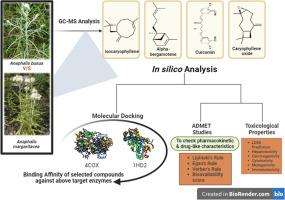Phytochemical profiling, molecular docking, and ADMET evaluation of essential oils from Anaphalis busua and Anaphalis margaritacea in Uttarakhand's Himalayan Terrain
Q3 Pharmacology, Toxicology and Pharmaceutics
引用次数: 0
Abstract
Background
The study focuses on a comparative analysis of essential oils derived from two species of the Anaphalis genus, namely Anaphalis busua and Anaphalis margaritacea, collected at varying elevations in the hilly terrain of Uttarakhand. The investigation aims to explore the phytochemical composition, conduct in silico molecular docking studies, and evaluate ADMET properties of the essential oils to understand their potential bioactivity.
Methods
Essential oils were extracted from the whole plants using the hydrodistillation method, and GC–MS was employed for compound identification. A total of 31 compounds were identified in A. busua and 32 in A. margaritacea, constituting 87.86 % and 87.83 % of the total composition, respectively. Major compounds included isocaryophyllene, caryophyllene oxide, geranyl-α-terpinene, α-pinene, γ-muurolene, δ-cadinene, humulene, and copaene.
Results
Molecular docking studies were conducted using PyRx software on ten notable compounds as ligands, targeting cyclooxygenase-2 (COX-2) and human peroxiredoxin 5 to assess antioxidant and anti-inflammatory activities. Isocaryophyllene, with concentrations of 14.07 % (A. busua) and 17.82 % (A. margaritacea), exhibited significant binding affinities of -5.7 and -7.2 kcal/mol against 1HD2 and 4COX, respectively.
Conclusion
The research provides valuable insights into the chemical composition of essential oils from Anaphalis plants and validates their bioactive potential through in silico analysis. Isocaryophyllene emerges as a key compound with noteworthy binding affinities, emphasizing its importance in the medicinal and pharmacological applications of essential oils derived from A. busua and A. margaritacea. The results enhance our understanding of the therapeutic potential of Anaphalis essential oils, opening avenues for future research in natural products and drug discovery.

北阿坎德邦喜马拉雅山区 Anaphalis busua 和 Anaphalis margaritacea 精油的植物化学成分分析、分子对接和 ADMET 评估
研究背景这项研究的重点是比较分析从北阿坎德邦丘陵地带不同海拔高度采集的两种阿纳佛手属植物(即阿纳佛手属 busua 和阿纳佛手属 margaritacea)中提取的精油。调查旨在探索植物化学成分,进行硅学分子对接研究,并评估精油的 ADMET 特性,以了解其潜在的生物活性。在 A. busua 和 A. margaritacea 中分别鉴定出 31 种和 32 种化合物,分别占总成分的 87.86% 和 87.83%。主要化合物包括异茶叶烯、氧化茶叶烯、香叶基-α-萜品烯、α-蒎烯、γ-木榄烯、δ-石竹烯、胡麻烯和椰油烯。结果使用 PyRx 软件对十种著名化合物进行了分子对接研究,以环氧化酶-2(COX-2)和人类过氧化物酶 5 为配体,评估其抗氧化和抗炎活性。异石竹烯的浓度分别为 14.07 %(A. busua)和 17.82 %(A. margaritacea),与 1HD2 和 4COX 的结合亲和力分别为-5.7 和-7.2 kcal/mol。异石竹烯是一种具有显著结合亲和力的关键化合物,强调了它在从 A. busua 和 A. margaritacea 提取的精油的药用和药理学应用中的重要性。研究结果加深了我们对杜鹃花精油治疗潜力的了解,为未来天然产品和药物发现研究开辟了道路。
本文章由计算机程序翻译,如有差异,请以英文原文为准。
求助全文
约1分钟内获得全文
求助全文
来源期刊

Phytomedicine Plus
Medicine-Complementary and Alternative Medicine
CiteScore
3.70
自引率
0.00%
发文量
178
审稿时长
81 days
 求助内容:
求助内容: 应助结果提醒方式:
应助结果提醒方式:


